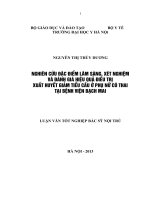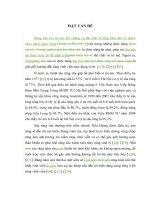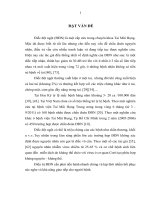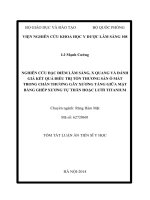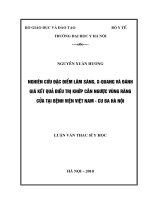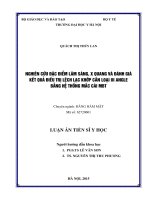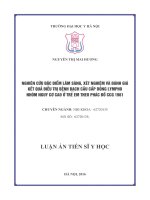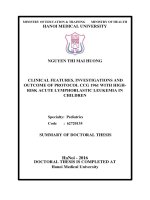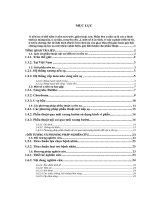Nghiên cứu đặc điểm lâm sàng, xét nghiệm và đánh giá kết quả điều trị bệnh bạch cầu cấp dòng lympho nhóm nguy cơ cao ở trẻ em theo phác đồ CCG 1961
Bạn đang xem bản rút gọn của tài liệu. Xem và tải ngay bản đầy đủ của tài liệu tại đây (241.06 KB, 34 trang )
Ministry of education & training
ministry of health
Hanoi medical university
NGUYEN THI MAI HUONG
CLINICAL FEATURES, INVESTIGATIONS AND
OUTCOME OF PROTOCOL CCG 1961 WITH HIGHRISK ACUTE LYMPHOBLASTIC LEUKEMIA IN
CHILDREN
Specialty: Pediatrics
Code
: 62720135
Summary of doctoral thesis
HaNoi - 2016
Doctoral thesis is completed at
Hanoi Medical University
Supervisors:
PhD. Bui Van Vien – Assoc.Prof.
Reviewer 1:
Prof. Do Trung Phan
Reviewer 2:
Prof. Mai Trong Khoa
Reviewer 3:
A. Prof. Tran Van Khoa
Doctoral thesis will be evaluated at thesis evaluation council at
Hanoi Medical University.
On ...a.m/ p.m ....../ ....../ 2016
You can find the thesis at:
- The National Library
- Library of Hanoi Medical University
- Library of Central Medical Information
3
Background
Leukemia is one of the most common types of cancer among
children around the world. This blood-related disease is caused by the
uncontrolled growth of one or many lines of malignant hematopoietic
stem cell. Acute lymphoblastic leukemia (ALL) accounts for
approximately 75% of all cases of childhood leukemia. In Asia, ALL
makes up 51% of leukemia cases in children under 15 year of age.
Children suffer from this disease, if not receive proper and timely
diagnosis and treatment, would die very quickly. Approximately
4900 children are diagnosed with ALL each year in the United States,
with an incidence of 29 per million of all US children. The peak
incidence of ALL occurs between 2 to 5 years of age and maybe
trending downward in both the United Kingdom and United States.
The incidence of ALL is higher among boys than girls, and this
difference is greatest among pubertal children.
In recent years, pediatric ALL is often cited as one of the true
success stories of modern medicine, with the cure rate improving
from zero prior to the advent of modern chemotherapy and radiation
therapy to current overall event- free survival (EFS) rate of about
80%. This success has been due to the development of classifications,
active chemotherapeutic agents, immunology, genetics and biomolecules into diagnosis, treatment, monitoring the disease and
understanding the prognosis factors. In Vietnam, the National
Hospital of Pediatrics (NHP) has made initiative in researches
regarding clinical and pre-clinical high-risk ALL on 164 patients in
2006 by Dr Nguyen Hoang Nam; another research is on treatment
outcome of standard risk ALL on 98 patients, with EFS is 68.1% by
Dr Bui Ngoc Lan. Other researches in different children and cancer
hospitals also have rough assessment regarding ALL treatment
results of different clinical protocol such as FRALLE (France), ALLBFM 90. So far, no research on high-risk childhood ALL with
4
complete assessment and proper clinical protocol applicable to
Vietnam has been conducted. Thus, we carried out our research on
the topic “Clinical features, investigations and outcome of
protocol CCG 1961 with high-risk ALL in children”. Two targets
of the research are:
1.
Describe the clinical features and investigations of high-risk
ALL in children at National Hospital of Pediatrics.
2.
Assess the treatment results of high-risk ALL in children using
modified protocol CGG 1961 at National Hospital of
Pediatrics.
Content: This article consists of 116 pages – Background (2
pages), Chapter I: Overview (36 pages), Chapter II: Patients and
methodology (17 pages), Chapter III: Results (28 pages), Chapter IV:
Discussion (29 pages), Conclusion (2 pages), Acknowledgement (1
page), Feedback (1 page). The result includes 45 tables, 8 graphs.
The research uses 99 references (in both Vietnamese and English).
Chapter I: OVERVIEW
1.1. EPIDEMIOLOGY
According to statistics, ALL remains the most common
malignancy in children, both in Vietnam and in the world. It occurred
initially in Great Britain in the 1920s, in the USA in the 1940s and
Japan in the 1960s. The appearance of this peaks correspond to major
periods of industrialization in this countries, suggesting that they may
reflect different periods of exposure to new environmental
leukemogens. The incidence of ALL in children across the globe is
between 1 to 4 cases/100.000 children below age 15. The geographic
variation may reflect, in part, the distribution of different
immunologic ALL subtypes. There appears to be lower incidence of
common ALL developing countries and higher incidence of T cell
ALL in the more industrialized countries. In Vietnam, the annual rate
of occurrence of cancer in children is 52 cases/million children. By
5
2013, the average number of children with cancer per year is 1405. In
NHP, leukemia accounts for 45.2% of childhood cancer, with ALL
makes up to 67.5% of these patients. Currently, the Department of
Oncology is using a CCG’s protocol of American, with modifications
for realistic application.
1.2. CLINACAL FEATURES AND INVESTIGATIONS
High-risk ALL in children has some clinical presentations and
investigations similar to other types of ALL such as signs and
symptoms reflect the impact of bone marrow infiltration with
leukemic cells and extent of extramedullary disease spread: the
lymphatic leukemia, central nervous system (CNS) leukemia and
other organs. Hematologic abnormalities include: full blood count,
blast cells dominate over other types of cells in the marrow.
Confirmation of ALL diagnosis is made more than 25% lymphoblast
in a bone marrow. Bone marrow samples will undergo
immunophenotyping and karyotyping to determine whether it is B or
pre-B cells ALL, T or AML. The result of karyotype will be used for
prognosis, thus to choose the appropriate protocol. Other tests
include chest X- ray to detect mediastinal tumors, coagulation test,
abdominal ultrasound, cerebrospinal fluid cells: central nervous
system penetrated when CSF has more than 5 WBC/mm 3,
lymphoblast are found.
1.3. PROGNOSTIC FACTORS AND RISK FACTORS
1.3.1. Classification by risk factors: Categorization by the National
Cancer Institute (America) divided ALL into 2 types:
- Standard risk: when patient is between 1 and 10 years old and
the initial leukocyte count is below 50G/L.
- High risk: Patients aged below 1 year old or ≥ 10 years old or the
initial leukocyte count greater 50G/L. ALL patients aged below 1 year old
normally have bad prognosis, thus a separate protocol is needed.
1.3.2 Prognostic factors:
6
- White blood cells count at diagnosis
- Age at diagnosis, gender, race, disadvantage such as:
hepatoslenomegaly and enlarge peripheral lymph node, central
nervous system infiltration, testicular leukemia, chromosome
abnormalities.
- Factors involved treatment: response to treatment in bone marrow
on day 7, day 14 and day 28. Lymphoblast <5% indicates a good
prognosis, 5-25%: incomplete remission and over 25%: no remission.
1.4. TREATMENT
High-risk ALL protocols all follow the principles based on
BFM protocol. The aim of initial ALL treatment is induction of
remission with agents. After complete remission has been achieved,
subsequent therapy is required to maintain the stability of the
remission: consolidation phase, intensification therapy. The
maintenance therapy with the total duration of 2 to 3 years is suitable
for pre B cell ALL and T cell ALL. The CCG 1961 protocol was
applied to patients in NHP since 2005. Patients are assessed on the 7 th
day of the induction phase, if lymphoblast of marrow is equal to or
below 25% (M1 and M2), the patients are rapid early response (RER)
and will follow arm B of the protocol. If lymphoblast is more than
25% (M3), patients are slow early response (SER) and will follow the
slow response of protocol CCG 1961. The outcome of this protocol
in America has an OS rate of 80.4% and an EFS rate of 71.3%.
Chapter II: PATIENTS AND METHODOLOGY
2.1.
PATIENTS
2.1.1. Clinical features and laboratory findings:
Observe on 129 patients diagnosed with high-risk ALL and
admitted to Department of Oncology in NHP between the period
1/6/2008 to 31/12/2012.
Selection Criteria:
7
2.1.1.1.
Leukemia diagnosis:
Clinical: Signs and symptoms: fever, fatigue, loss of appetite.
Anemia, petechie or bleeding. Extramedullary disease spread:
mediastinal mass, testicular leukemia, the degree of
hepatoslenomegaly, lymphadenopathy, nervous central symptoms
disease, pain of the bone.
- Full blood count: Hemoglobin (Hb), WBC count may be
increased, normal or decreased but usually there is a substantial
decrease in neutrophils number, lymphoblast may be found in blood
capillaries, platelets count usually decreases.
- Bone marrow smear: if lymphoblast ≥ 25% of blood cells in
bone marrow, the patient would be diagnosed with leukemia. This is
the golden standard to determine leukemia and morphologic
classification via FAB. In the bone marrow, lymphoblast will
dominate over other types of blood cells such as leukocyte, red blood
cells and platelets.
2.1.1.2. ALL diagnosis:
- POX (Peroxidase) negative on bone marrow cells.
- Calssification immunophenotype: Undergo flow cytometry,
MPO (Myelo Peroxydase) negative. Three immunologic subsets were
delineated: T cells, B cells and non T/non B cells.
2.1.1.3. High-risk ALL diagnosis:
- Patients aged > 1 and ≤ 10 with WBC count ≥ 50 G/L,
- Patients aged > 10 at time of diagnosis,
Criteria based on unfavorable prognosis of ALL:
- Patients with biphenotype (immunophenotype) .
- Patients with translocation t(9;22), t(4;11)
- Patients with hypodiploidy (<45 chromosomes)
2.1.2. Outcome of CCG 1961 protocol treatment:
8
The target patients for research are 102 ALL patients admitted
to Department of Oncology of NHP between the period 1/6/2008 to
31/12/2012.
Patients are treated and monitored according to CCG 1961
protocol. The time of observation is until 31/5/2015.
2.2. METHODOLOGY
2.2.1. Planning: Experimental study without case-control groups,
consisting of 2 parts: - Part 1: Describe study, with cross-sectional
description clinical features and investigations of children diagnosed
with high-risk ALL admitted to NHP.
- Part 2: Prospective study the results of high-risk ALL patients
according to modified CCG 1961 protocol.
2.2.2. Content:
2.2.2.1. Content for goal 1: Research on clinical features and
investigations:
- Categorization based on aged at time of admittance, gender,
clinical presentations and laboratory findings.
- Bone marrow aspiration are collected to assess classification:
Morphology (FAB), Immunophenotype of lymphoblast: pre B cells,
T cells, biphenotype. Chromosomal abnormalities: Structure and
number.
- Biochemical charaterization: liver and kidney function,
calcium, glucose level, tumor lysis syndrome, coagulation test:
Fibrinogen, Prothrombine, APTT, CRP to determine the infection.
- Prognostic factors: age, gender, hepatosplenomegaly,
lymphadenopathy, Hemoglobine level, WBC count, platelets count at
the time of diagnosis and comparision the other unfavorable factors.
9
2.2.2.2 Research content for goal 2: Assessment on the results of
ALL treatment according to modified CCG 1961 protocol.
The protocol being used for treatment is the US CCG 1961
arm B. This is a protocol for high-risk ALL patients, with some
modifications for better application in Vietnam context such as: LAsparaginase is a form of E. Coli ASP from Kyowa (Japan), 6
thioguanin is replaced by 6MP; intrathecal by cyratabine day 0 is
replaced by MTX.
- Assessment on induction phase, bone marrow aspiration day 28.
- Assessment post- induction phase.
+ Total number of patients complete therapy
+ Number of patients relapse
+ Number of patients undergoing treatment
+ Number of patients dies during treatment.
+ Hematologic abnormalities, other abnormal laboratory
findings during induction phase.
+ OS based on Kaplan-Meier
+ EFS based on Kaplan-Meier
+ OS and EFS by ages based on Kaplan-Meier
+ OS and EFS by gender based on Kaplan-Meier
+ OS and EFS by RER and SER based on Kaplan-Meier
+ Prognostic factors involved OS analysis based on Cox’s
proportional hazard model.
2.2.3. Assessment criteria:
- Complete remission: no clinical signs and symptoms, full
blood test and bone marrow test results are M1. Incomplete
remission: bone marrow result is M2, clinical symptoms are
mitigated compared to before treatment. Failure remission: bone
marrow result is M3, clinical symptoms are not mitigated.
- Relapse: Lymphoblast rate in bone marrow is ≥ 25%.
Testicular relapse is when testicle swells and hurts, when poked with
small needles, lymphoblast is found. Central nervous system relapse:
10
when patients show signs of headache, vomiting, damage in cerebral
nerves and CSF contain lymphoblast at a rate of > 5 cells/mm 3.
- Assessment of side effects: on coagulation, on peripheral
blood cells and bone marrow according to the standard in CCG 1961
protocol. Infection assessment, anemia and tumor lysis syndrome,
- Close follow up patients during and out of resident time, and
during regular check-up time according to CCG 1961 protocol.
Chapter III: RESULTS
3.1 CLINICAL FEATURES AND INVESTIGATIONS:
The research is conducted on 129 patients with 87 boys
(67.4%) and 43 girls (32.6%), boy: girl ratio is 2.07. Average age: 7.0
± 4.4. Aged 1-5: 45.7%, aged ≥ 10: 31.8%, aged 5-10: 22.5%.
3.1.1 Clinical presentations:
Table 3.1: Clinical features usually found in ALL
Clinical features
Fever
Hepatomegaly
Hemorrhage
Spleenomegaly
Lymphadenopathy
Pain of the bone
Number of patients
117
95
84
83
54
39
Percentage
90,7%
73,6%
65,1%
64,3%
41,9%
30,2%
Comments: Most patients admitted to NHP show signs of
fever, sporadic or continuous fever makes up 90.7%. 65.1% of
patients have hemorrhage. High-risk ALL patients usually have these
symptoms: hepatomegaly, sleenomegaly and lymphadenopathy at the
percentage of 73.6%, 64.3% and 41.9% respectively. Pain in the bone
is less common at 30.2%.
3.1.2 Full blood test characteristics:
Table 3.2: Full blood test characteristics
11
Blood index
Patients
Hb:
< 60 g/L
26
60- 90 g/L
72
90- 110 g/L
22
> 110 g/L
9
WBC:
< 10 G/L
24
10 - < 50 G/L
31
≥ 50 G/L
74
Platelets: < 20 G/L
38
20- 99 G/L
68
≥ 100 G/L
23
Percentage
Average
20,2%
55,8%
76,5 ± 20,69 (3117%
140 g/L)
7%
18,6%
110,8± 136,14
24,0%
(0,7- 686,5 G/L)
57,4%
29,5%
62,4 ± 93.46
52,7%
(4- 544 G/L)
17,8%
Comments: Blood tests show that more than half of patients
suffer from mild anemia (55.8%); 7% have normal Hb. The average
Hb level is 76,5± 20,69 g/L. 57,4% of the patients has WBC count ≥
50 G/L, while patients with WBC count < 10 G/L only makes up
18.6%, average WBC count is 110,8± 136,14 G/L. 82,2% of the
patients have reduced platelets count < 100 G/L, 17.8% has normal
platelets.
3.1.3 Bone marrow characteristics of high-risk ALL
Elevated number of bone marrow cells during diagnosis
accounts for 60.4% of the patients, while decreased number of bone
marrow cells during diagnosis is only 7%. The average bone marrow
cells count is 196,9 ± 155,8 (between 2,9 G/L & 729,2 G/L).
Lymphoblast percentage is within the range of 29% to 99%, the
average is 82.6 ± 14.7%. Among high-risk ALL, morphologic
classification (FAB): L1 makes up the majority: 55%, L2 is less
common with 40.3%. Based on morphology alone, there is a small
number of patients, 6/129, wrongly diagnosed with AML (4.7%).
Pre B cell ALL has 105 cases (81.4%), T cell has 17 cases (13.18%).
There are 3 cases (2.32%) in which it is not possible to identify the type
of ALL. Among 129 patients there are 105 cases of CD10 (+),
accounting for 81.4% and 24 cases of CD10(-), which is 18.4%. There
12
are 29/129 patients (22.48%) are biphenotype or preB, T doimanted with
traces of cell-mediated immunity from other types of cells.
Cytogenetic of high-risk ALL: there are only 97 patients shows
positive results for chromosomal culture from lymphoblast.
Table 3.3 Results of chromosomal culture from lymphoblast
Chromosomal culture
Patients
Percentage
Normal
58
59,8%
Hypodiploidy
23
23,7%
Hyperdiploidy
4
4,1%
Abnormal chromosome
12
12,4%
Total
97
100%
Comments: 59.8% of patients have normal karyotype (46 XX
or 46XY). 23.7% of patients have hypodiploid (<45). 12.4% of
patients have abnormal chromosomes. There are only 4 cases (4.1%)
in which patients have hyperdiploid (>47 XX or >47 XY), these
factors have good prognosis.
Among the 12 patients with abnormal chromosomes,
translocation is the most common mutation – 6/12, followed by
deletion (4/12) and addition (3/12).
Translocations found are t(9;22)(q34;q11.2), t(3;12)(q26;p13),
t(9;12)(p24;q36), t(1;2)(p36;q36) and t(1;19(q23;p13). Deletions
found are del(6)(q15), -6, -16; del(4)(q32;q34); del(3p), del(12q) and
del 11q. Additions include add (8)(q23), +14, +20. Some patients’
chromosome shows both deletion and addition and translocation.
3.1.4 ALL-related prognosis factors
Comparisons between unfavorable factors such as WBC count
during diagnosis, age, gender, biphenotype, hypodiploid between
boys and girls, between the age groups above and below 10 shows
that WBC ≥ 50 G/L is more common among children under age 10
than among children above age 10 (p < 0.01).
3.2 OUTCOME OF TREATMENT BASE ON CCG 1961
PROTOCOL
13
Among the 129 high risks ALL patients there are 102 patients
who are treated according to CCG 1961 protocol. The patients are
followed up from the start of treatment until death or until the end of
treatment and regular check-up afterwards. The end of monitoring
time is 31/5/2015. The results are 12 patients died during the
induction phase (11.76%) while the other 90 got into complete
remission (88.24%). 77 patients were treated according to arm B of
CCG 1961 protocol due to RER and 13 followed SER protocol. 5
patients were still undergoing treatment (4.9%) and 42 completed
treatment (41.18%).
3.2.1 Induction phase results:
Among 102 patients treated according to the CCG 1961
protocol, 3 died before day 7 of the induction phase, 95 others
undergo bone marrow aspiration to examine the responsiveness to the
treatment. Results are as follow:
Table 3.4. Bone marrow on day 7 of induction phase
On day 7
Patients
Percentage %
M1
75
75,8
M2
8
8,1
M3
16
16,1
Total
99
100
Comments: Percentage of patients who reach RER is 82.9%
(75.8% M1 and 8.1% M2), only 16.1% have SER (M3). Patients with
M2 and M3 will have their bone marrow aspirate on day 14 of
induction phase. Results show that 8 M2 patients reach M1 on day
14, 11 M3 patients reach M1 on day 14 (68.75%), 2 patients died
before day 14 and 3 reach M2 (18.75%).
Side effects occurred during induction phase are: fever
(59.8%), stomachache (27.5%), vomiting and nausea (41.2%),
diarrhea (18.6%), constipation (11.8%), mouth ulcer (50%),
pneumonia and broncho-alveolitis (11.8%).
During the induction phase, patients undergo many rounds of
blood test, coagulation test and biochemical test. Hb, WBC and
14
platelets count usually undergo substantial drop (level III and IV),
along with bone marrow cells. Prothrombine ratio, fibrinogen ratio
and liver function (SGOT, SGPT) usually have less changes (level I
and II). Glucose level increases substantially, there are 7 cases
(6.86%) with > 10 mmol/L due to side effects of L-Asparaginase and
dexamethasone, 21 patients (20.59%) has decreased sodium level
(<130 mEq/L), 12 (11.7%) has decreased potassium level (< 3
mEq/L) and 36 (35.29%) has decreased calcium level (< 2 mEq/L).
Elevated glucose will stop when L-Asparaginase and dexamethasone
are no longer used.
Table 3.5 Results of induction phase
Results
Complete remission
Fatality
Total
Number of patients
90
12
102
Percentage
88,24%
11,76%
100%
Comments: 88.24% of patients reach complete remission by
the end of induction phase. 12 patients (11.76%) died during
treatment.
80 patients undergo blood culture during induction phase,
among them 21 cases (26.25%) has positive. Bacteria that can be
found are mostly nosocomial infection. Bacteria that can be isolated
are: K. Pneumoniae, Staphylococcus Aerius, Staphylococcus group
F, E. Coli, Pseudomonas Aeruginosa, Acinetobacter Sp, Serratia
Marcescens and Candida fungus.
3.2.3 CCG 1961 protocol results based on Kaplan-Meyer
90 patients continue post- induction and follow up (77 RER
and 13 SER). Results show that 17 suffer from relapse (16.67%) and
26/90 patients died post- induction. Total number of patients under
observation by the end of research is 47.
15
Graph 3.1 OS ratio based on Kaplan-Meier.
Percentage of OS patients for 5 years is 48.6 ± 5.0%, survival
for 1 year is 72.5% and survival for 2 years is 54.7%.
Graph 3.2 EFS ratio based on Kaplan-Meier.
EFS ratio for 5 years is 46.0 ± 5.0%. Survival after 1 year rate
is 68.6% ± 4.6%, survival after 2 years rate is 53.7% ± 5.0%.
Table 3.6. OS and EFS by gender
Gender
5 years OS
5 years EFS
%
SD
95% CI
%
SD
95% CI
16
Boys
Girls
54,8
30,5
4,6 45,8 – 63,7
4,5 21,7 – 39,4
p = 0.006
52,9
29,6
4,6 43,9 – 61,9
4,6 20,6 – 38,6
p = 0.01
Comments: Boys have higher OS ratio than girls, 54.8% ±
4.6% and 30.5% ± 4.5% respectively. EFS ratio of boys is also higher
than that of girls (52.9 ± 4.6% and 29.6 ± 4.6%). Statistical
significance p < 0.05.
Table 3.7 OS and EFS by age group
Age
5 years OS
5 years EFS
%
SD
95% CI
%
SD
95% CI
46,
45,
< 10
6,2 34,7 – 59,0
4,5
36,3 – 54,0
8
1
47,
46,
≥ 10
4,5 38,3 – 55,9
6,3
33,7 – 58,5
1
1
p = 0.97
p = 0.905
Comments: OS and EFS for children aged above and below
10 is 47.1±4.5% and 46.8±6.2%, 45.1±4.5% and 46.1±6.3%
respectively. There is no difference between the two age groups
(p>0.05).
Table 3.8. OS and EFS by bone marrow response on day 7.
OS by day 7 response EFS by day 7 response
Day 7 response
%
SD
95% CI
% SD
95% CI
47,
RER
49,6 3,9 41,9 – 57,3
3,9 40,1 – 55,6
8
30,
SER
31,1 8,1 15,1 – 39,8
8,3 14,2 – 46,6
4
p = 0.069
p = 0.09
Comments: OS and EFS ratio of the RER on day 7 of
induction phase are higher than that of the SER group (49.6% and
47%, 31.1% and 30.4%). However, this difference has no statistical
significance (p>0.05).
17
Univariate analysis based on Cox’s proportional hazard model on
some prognostic factors such as age, gender, WBC count at
diagnosis, lymphoblast on day 7 of induction phase, hypodiploid,
translocation t(9;22), biphenotype, renal insufficiency, CD 10 (-)
show that: gender factor and renal insufficiency affect patients’ OS
(p<0.05). Multivariate analysis on prognostic factors that affect OS
indicates: 4 factors: gender, tumor lysis syndrome, lymphoblast day 7
and hypodiploid or translocation t(9;22) affect patients’ OS ratio
(p<0.05).
Chapter IV: DISCUSSION
4.1 CLINICAL PRESENTATIONS AND LABORATORY
FINDINGS
4.1.1 Epidemiology and clinical presentations:
In our research, 129 patients are categorized into the high-risk
ALL group. Among them, 102 undergo treatment and follow up
according to the CCG 1961 protocol until the end of the research. In
the high-risk ALL group, child patients aged above 10 are 31.8%, the
majority of patients aged between 1 to 5: 45.7%. NH Nam shows that
children aged ≥ 10 accounts for 46.3% while children aged 1-5
accounts for only 29.8%. This indicates that children are more likely
to be categorized into high-risk group based on other poor conditions
such as high WBC, hypodiploidy, biphenotyping. America with CCG
1961 protocol there are 1299 patients, age above 10 group takes up
63.2% (821 patients), age under 10 takes up 36.8% (478 patients).
Boy: girl ratio is 2.07. This result is similar to that of local and
foreign researchers – more commonly found in boys than in girls.
Table 3.1 shows the clinical features on admission: fever is the most
common (90.7%), followed by hepatomegaly, spleenomegaly and
lymphadenopathy, petechie and bone pain. These are similar to what
is found by NH Nam and Judith FM. There is no difference in terms
18
of clinical characteristics between T and B cells ALL.
4.1.2 Hematologic characteristics:
Table 3.2 shows hematologic abnormalities at presentation.
We usually visit cases in which upon diagnosis at NHP, lymphoblast
have been found, for some children, lymphoblast take up 90%, other
types of blood cells decrease substantially. Children ALL admission
are usually afflicted with anemia by WHO standards (average Hb is
76.5g/L), very few patients do not have anemia (7%). WBC ≥ 50G/L
is 57.4% while Judith FM only has 17% and patients without anemia
is 12%, NH Nam has WBC at diagnosis ≥ 50G/L of 70.7% and 11%
of patients have no anemia. Patients with the highest WBC is 686.51
G/L. Platelets < 100G/L is 82.2%, similar to the 2 other local and
foreign researchers. This shows that children ALL usually go to the
hospital late. Since lymphoblast dominates over other types in bone
marrow, all patients have decreased number of neutrophils, which is
also the reason for fever due to bacterial infection, children will be
treated with antibiotics and chemotherapy together.
4.1.3 Lymphoblast in bone marrow:
Classification FAB is still applied in Vietnam, this is the initial
categorization that helps researchers to plan other tests such as
immunophenotypic, cytogenetic, FISH. The FAB system defines L2
usually has worse prognosis than L1 in ALL although this
characteristic no longer holds prognosis value recently. However, in
some cases, morphologic classification is not adequate to make an
accurate diagnosis and small number of patients was wrongly
diagnosed with AML (4.7%), hence determination of the
immunophenotype classification is needed. The most common of
immunophenotype in childhood ALL is B cell (81.4%), T cell is
13.18%. The percentage of lymphoblast found in this research is
similar to that of other overseas researches: 80-85% of childhood
19
ALL cases have predominant B cell precursors, T-cell is 15-20% of
the cases across different researches. In our research, there are 29
cases (22.48%) of biphenotype (T or B cells or AML) but 25 cases
have either B or T cell as the dominant phenotype, 4 cases in which
both phenotypes are equally represented. Other researched in the
world shows that ALL children with AML markers is 7-25%.
Patients with ALL antigen CD 10 (+) or common ALL has better
prognosis than those with CD10 (-), this results confirmed that 18.6%
of patients has CD10 (-) and 81.4% has CD10 (+), patients with
CD10 (-) usually have other unfavorable prognosis such as elevated
WBC count, hypodiploid.
Cytogenetic: Since 2007, the Department of Bio- Molecular
Genetics of NHP has started chromosomal culture for patients who
are assumed to have leukemia. Until now, this test has been done
frequently. However, we have limited results since the normal results
takes up 59.8% whereas only 40.2% has abnormal chromosome, this
result in overseas centre discovers 80% chromosomal abnormality
among ALL patients. Nowadays, thanks to modern technology, in
almost 100% of the cases, chromosomal abnormality is detected.
Table 3.3 shows that the results of chromosomal culture from
lymphoblast include: structural chromosomal abnormalities 12.3%
(12/97 patients) and number chromosomal abnormalities:
hypodiploidy 23.7% and hyperdiploidy is 4.1%. About structure:
6/12 is translocations, deletion is 4/12 and addition is 3/12. We only
encounter 2/12 cases of unfavorable prognosis translocation t(9;22).
High- risk ALL chromosomal abnormalities in our research with that
of PNT Van 2013 shows lower results. When doing research on
chromosomal abnormalities in both childhood and adult ALL, this
author discover 4 abnormal genetic combinations of 4 translocations
t(12;21), t(9;22), t(4;11), t(1;19) takes up 25.7%. Nita LS has the
20
percentage of patients with hypodiploid in 2 patient groups of 7.2%
and 12.3%. Thus, NHP needs to apply more advanced technology to
detect chromosomal abnormalities in ALL to help doctors choose the
appropriate protocol. The 2 patients whose harmful translocation
t(9;22) are detected and treated with CCG 1961 protocol have
unfavorable prognosis such as elevate WBC count (181 G/L and
82.55G/L), hepatosplenomegaly, no response to treatment (M3 on
day 7 of induction phase), one child aged above 10 and early relapse
after consolidation phase, 1 child died after 4 months of treatment
due to severe infection. In another patient 11q deletion is detected,
which is a poor prognosis, this patient relapse early after 5 months of
treatment. Hence, in our research, chromosomal abnormalities with
unfavorable prognosis [hypodiploid, t(9;22) and 11q deletion] takes
up 63.4% (26/41) of all the cases of chromosomal culture with
abnormal results.
4.3 OUTCOME BASE ON CCG 1961 PROTOCOL:
4.3.1 Induction phase results:
According to CCG 1961 protocol, bone marrow aspirate must
be checked on day 7 of induction phase to assess the response to
treatment. Our research indicates that RER percentage is 83.9%
(75.8% M1 and 8.1% M2), SER (M3) is 16.1% (table 3.4). When
compared this result with that of the CCG 1961 research group (RER
is 71.4% & SER is 28.6%), our SER percentage is higher but the
death ratio before day 7 is higher (3/102) than that of CCG 1961
research (3/2057), showing that supportive care with ALL
chemotherapy is an important factor leading to patients passing the
induction phase. Depends on each protocol, patients will undergo
bone marrow assessment either on day 7 or day 14. Arika M (Japan)
from 1988-1999 on 116 patients, which assess on day 14 shows that:
69 children are M1 (59.5%), 25 patients are M2 (21.6%), 22 patients
21
are M3 (18.9%). This result is similar to ours. Before the end of
induction phase, bone marrow aspirate will be carried out, we have
90 patients whose bone marrow assessment on day 28 confirms
complete remission (M1) reach 100%. Schrappe M shows that failure
therapy in this phase is 2.4%. Table 3.5 shows that complete
remission after induction phase has 88.24%, death rate in this phase
is 11.76%. Meanwhile, the American CCG 1961 research group has
21/2057 (1.02%), other groups in the world also have death rates in
this stage between 1-2%. CV Ha (Hue) reported the ALL treatment
death rate is 44% in the first 28 days of treatment. The reason for the
high death rate is severe infection due to neutropenia and
uncontrolled bleeding, brain hemorrhage. Comparing with other
research groups in the world shows that death rate during induction
phase is a serious problem that requires attention, supportive care
such as proper & effective antibiotic usage and adequate supplement
of blood products to prevent possible strokes has large impact on
treatment results.
4.3.2 Side effect and toxic during induction phase:
The induction phase uses 4 drugs, thus the patient has to
endure a large amount of chemotherapy, leading to more side effect
as myelosuppression due to leukopenia, anemia, thrombocytopenia.
There are some, but not significant, differences between the side
effect ratio researched and that of researches by LT Phuong and BN
Lan. These side effects are usually most serious from day 7-14 of the
first stage, corresponding to mycositis, severe infection and fever
neutropenia. When the bone marrow recovers, infection and
mycositis in children also decrease and return to normal on week 4 of
induction phase.
4.3.3 Post induction of CCG 1961:
Among the 102 patients treated and follow up according to
22
CCG 1961 protocol by the end of the research, 31/5/2015, the longest
monitoring period from diagnosis to the end of the research is 84
months, the shortest period is 1 week when the patient died. There
are 47 patients alive and among them 5 are expected to stop treatment
in August (2 patients), December (2 patients) and 1 patient will stop
in October 2015. By the end of the research, among the 38 deaths: 12
were during induction phase with the earliest being 1 day after
starting treatment and latest being 26 days before the completion of
induction phase (28 days).
Relapse percentage is 16.67% (17 patients), among them 15
patients relapse while the treatment (2 patients relapse very early in
less than 6 months), this may be explained by unfavorable factors
such as high level WBC ≥ 50G/L at diagnosis, hepatosplenomegaly,
in 1 child we also find translocation Philadelphia t(9;22), monosomy
chromosme 7 and hypodiploid, 1 child with 11q deletion. 2 patients
relapse late. Other groups with the same relapse results: Ma-Spore
17.9%; CCG 1961 16.92%; UKALL 97-99: 16%. All 17 cases are
bone marrow relapse with 1 case of testicular relapse and marrow
relapse, no CNS relapse found. The number of patient’s dies of post
induction phase is 26 (25.5%). Our number is rather higher than MaSpore group, high-risk ALL has 78 patients and they have 7 patients
died during treatment (9%). Australia uses the ANZCHOG (Study
VIII) protocol for 66 high-risk ALL, death rate during treatment is
4.5% (3 patients). All these patients’ deaths in our research are at
home or local hospitals due to uncontrolled bleeding or infection
before being transferred to NHP.
4.3.4 Outcome based on Kaplan-Meier:
Graph 3.1 & 3.2 shows OS and EFS rates 5 years. Based on
this estimation, our OS result is 48,6 ± 5,0% and EFS is 46 ± 5,0%.
This is a humble result when compared to the result of CCG 1961
23
protocol published by Nita LS in 2007 with 80,4 ± 1,4% for OS and
71,3 ± 1,6% for EFS. Allen Yeoh (Singapore 2012) applied MaSpore protocol in 2003 give the results of 71.8% for OS rate 5 years
and 50.6% for EFS rate 5 years. Arika M (Japan) has OS rate for
high-risk group at 68,7 ± 8,3%. Veeman A (Holland) published the
high-risk ALL treament based on Dutch ALL-9 (1997-2004) results
of 71% for OS rate and 78% for EFS rate (5 years). This shows that
not only using the correct medicine based on the protocol but also the
doctor must have enough experience in supportive care and side
effect treatment well, isolation therapy and healthy nutrition also
increase patients’ survival rates. Patients’ deaths in our research are
mostly due to infection as a result of severe neutropenia decrease and
uncontrolled bleeding. Comparing OS and EFS 5 years ratio between
boys and girls in our research shows significant difference: boys have
better ratio than girls, this difference is statistically significant when
p < 0.05. Allen Yeoh published the treatment results based on MaSpore protocol in 2003 when comparing between 2 genders show no
difference, EFS rates after 8 years are 80% in boys and 81.1% in
girls. Chritensen MS shows that boys have worse prognosis factors
than girls but did not die of infection, girls have higher death rates
due to infection of 4.4% compared to 2.1% in boys. Comparison
results of OS and EFS between 2 age group in our research are
different from that of other authors in the world. Allen Y research
based on Ma-Spore protocol shows that there is a statistically
significant difference between the EFS rate of 2 groups above and
below 9 years old (p=0.000), survival rate for age group >9 is 73.4%
while age group <9 is 83.8% after 8 years. Bauruchel A shows that
survival rate for age group <10 is higher than that of age group >10
in research by Dana Farber Cancer Institute (1991-2000), children
24
aged below 10 (n=685) and children aged above 10 (n=108) shows
EFS rates after 6.5 years is 85%±1% & 77%±4%. However, these
results do not have statistical significance (p=0.09). Among 90
patients continued with CCG 1961 protocol there are 77 show RER
and 13 show SER on day 7 of induction phase. Comparison in terms
of OS and EFS rates between these 2 groups show that RER patients
have higher survival rate than SER patients. However, this difference
is not statistically significant (p>0.05), maybe because the number of
SER patients is small when among 16 SER patients only 6 complete
treatment.
CONCLUSION
Based on research on 129 high-risk ALL patients and
treatment based on CCG 1961 protocol for 102 patients at the
Department of Oncology at National Hospital of Pediatrics, we reach
these conclusions:
1. Clinical features and investigations of high-risk ALL patients:
- Children afflicted with high-risk ALL at NHP are usually
between age 1-10 (69.2%), male patients are more common than
female patients (boys: girls ratio is 2.07). The noticeable clinical
characteristics of children admitted to hospital and suspected of
leukemia is fever, pain in the bone, petechie, hepatosplenomegaly
and lymphadenopathy. There is no difference in terms of clinical
characteristics between B cell and T cell ALL.
25
- Hematologic characteristics: Anemia with Hb <90g/L takes
up 76%, WBC count ≥ 50G/L is 57.4%, platelet ≤ 20G/L takes up 1/3
of the cases (29.5%). Lymphoblast rate of bone marrow is high
(average 82.6%).
- Based on FAB classification, L1 high-risk ALL is more usual
than L2 (55% versus 40.3%), a small percentage (4.7%) are AML but
immunophenotype assessment shows ALL. Pre B high-risk
childhood ALL takes up 81.4%, T is less common (13.18%), pre B or
T ALL can be found but with other markers or biphenotype.
- Karyotype culture from bone marrow detect 40.2% with
chromosomal abnormalities, among them hypodiploid is 23.7% and
structural chromosomal abnormalities is 12.4%. Chromosomal
abnormalities ratio with unfavorable prognosis [hypodiploid,
translocation t(9;22) & 11q deletion] takes up 63.4% (26/41) of cases
with abnormalities.
2. Treatment based on CCG 1961 protocol results:
- Complete remission of induction phase is 88.2%.
- OS rate and EFS rate 5 years based on Kaplan-Meier
estimation are 48.6% and 46% respectively; boys have higher
survival rates than girls (54.8% and 52.9% compare to 30.5% and
29.6%) with statistical significance with p<0.05; the ratio of RER is
higher than that of SER (49.6% & 47.8% compare to 31.5% &
30.4%) (p> 0.05).
- Common death rate is 37.25%, most are in induction phase
and intensification phase. The common cause of death is serious
infection and bleeding.
- Relapse percentage is 16.7%. Unfavorable factors such as
gender, lymphoblast on day 7 of induction treatment, tumor lysis
syndrome, hypodiploid and translocation t(9;22) have effect on
outcome.
